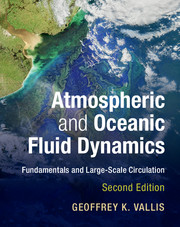Book contents
- Frontmatter
- Dedication
- Contents
- Preface
- Notation
- PART I FUNDAMENTALS OF GEOPHYSICAL FLUID DYNAMICS
- PART II WAVES, INSTABILITIES AND TURBULENCE
- PART III LARGE-SCALE ATMOSPHERIC CIRCULATION
- 14 The Overturning Circulation: Hadley and Ferrel Cells
- 15 Zonally-Averaged Mid-Latitude Atmospheric Circulation
- 16 Planetary Waves and Zonal Asymmetries
- 17 The Stratosphere
- 18 Water Vapour and the Tropical Atmosphere
- PART IV LARGE-SCALE OCEANIC CIRCULATION
- References
- Index
14 - The Overturning Circulation: Hadley and Ferrel Cells
from PART III - LARGE-SCALE ATMOSPHERIC CIRCULATION
Published online by Cambridge University Press: 09 June 2017
- Frontmatter
- Dedication
- Contents
- Preface
- Notation
- PART I FUNDAMENTALS OF GEOPHYSICAL FLUID DYNAMICS
- PART II WAVES, INSTABILITIES AND TURBULENCE
- PART III LARGE-SCALE ATMOSPHERIC CIRCULATION
- 14 The Overturning Circulation: Hadley and Ferrel Cells
- 15 Zonally-Averaged Mid-Latitude Atmospheric Circulation
- 16 Planetary Waves and Zonal Asymmetries
- 17 The Stratosphere
- 18 Water Vapour and the Tropical Atmosphere
- PART IV LARGE-SCALE OCEANIC CIRCULATION
- References
- Index
Summary
THE LARGE-SCALE CIRCULATION OF THE ATMOSPHERE is normally taken to mean the flow on scales of the weather — several hundred or a thousand kilometres, say — to the global scale. The general circulation is virtually synonymous with the large-scale circulation, although the former is sometimes taken to be the time- or ensemble-averaged flow. Our goal in this and the next few chapters is understand this circulation and other properties of the atmosphere that accompany it — the temperature and moisture fields, for example. We might hope to answer the simple question, why do the winds blow as they do? In this chapter we focus on the dynamics of the Hadley Cell and, rather descriptively, on the mid-latitude overturning cell or the Ferrel Cell, moving to a more dynamical view of the extratropical zonally averaged circulation in Chapter 15.
The atmosphere is a terribly complex system, and we cannot hope to fully explain its motion as the analytic solution to a small set of equations. Rather, a full understanding of the atmosphere requires describing it in a consistent way on many levels simultaneously. One of these levels involves simulating the flow by numerically solving the governing equations of motion as completely as possible by using a comprehensive General Circulation Model (GCM). Such a simulation brings problems sof its own, for example understanding the simulation itself and discerning whether it is a good representation of reality, and so we shall concentrate on simpler, more conceptual models and the basic theory of the circulation. We begin this chapter with a brief observational overview of some of the large-scale features of the atmosphere, concentrating on the zonally-averaged fields.
BASIC FEATURES OF THE ATMOSPHERE
The Radiative Equilibrium Distribution
A gross but informative measure characterizing the atmosphere, and the effects that dynamics have on it, is the pole-to-equator temperature distribution. The radiative equilibrium temperature is the hypothetical, three-dimensional, temperature field that would obtain if there were no atmospheric or oceanic motion, given the composition and radiative properties of the atmosphere and surface. The field is a function of the incoming solar radiation and the atmospheric composition, and its determination entails a complicated calculation, especially as the radiative properties of the atmosphere depend heavily on the amount of water vapour and cloudiness it contains.
- Type
- Chapter
- Information
- Atmospheric and Oceanic Fluid DynamicsFundamentals and Large-Scale Circulation, pp. 511 - 538Publisher: Cambridge University PressPrint publication year: 2017



